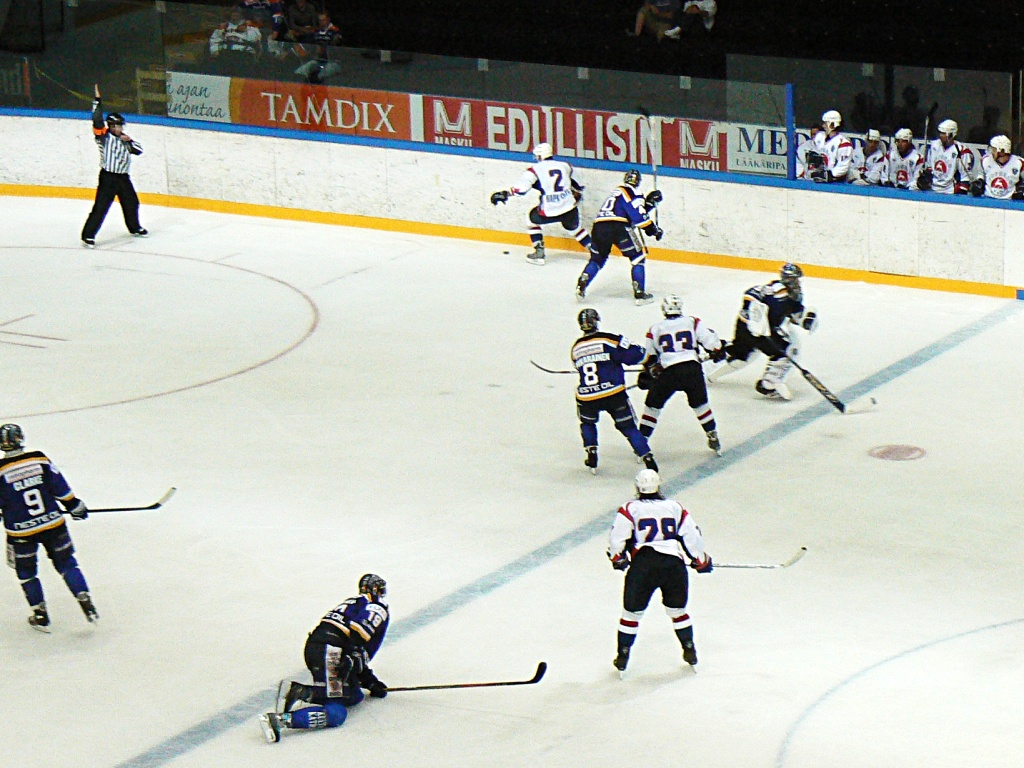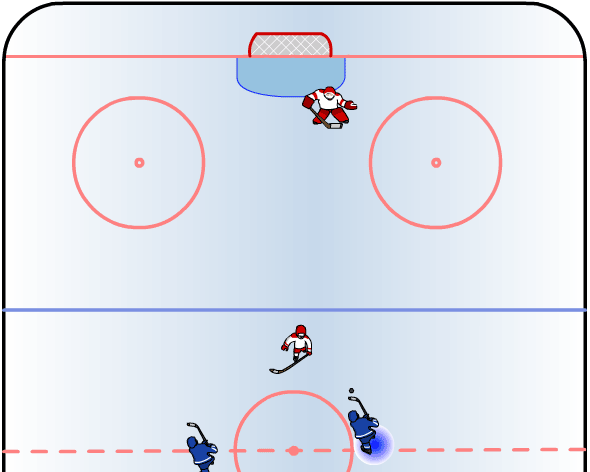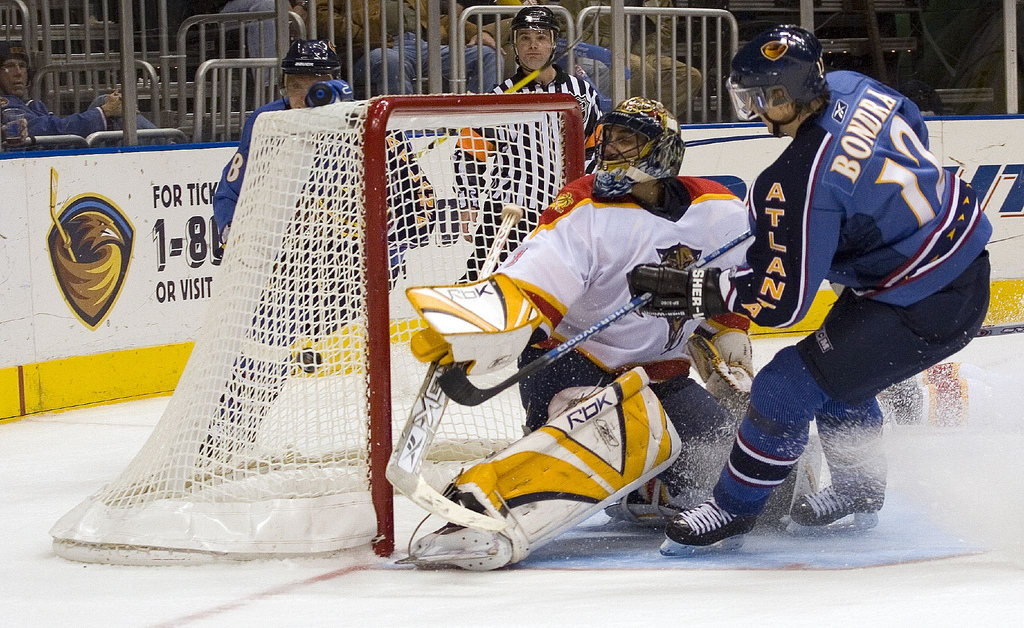|
Igor Dorokhin
Igor Lvovich Dorokhin (russian: Игорь Львович Дорохин; born August 15, 1962) is a former Kazakhstani-German professional ice hockey player, who played for Kazakhstan National Hockey Team. He is the former head coach of Kazzinc-Torpedo and his farm club Kazzinc-Torpedo-2. Career Igor Dorokhin is the graduate of Ust Kamenogorsk ice hockey school. He has begun his playing career at the youth Torpedo Ust-Kamenogorsk team. In 1979, he won in the Soviet Union Youth Hockey Championships. That team was under his first professional coach Vladimir Goltze. From 1984 to 1992, he played for basic team of Torpedo Ust-Kamenogorsk. After Soviet Union collapse, he went to play in Germany. He won at the Eishockey-Bundesliga in 1995, when he was playing for EHC Freiburg. He has lived in Germany 19 years and finished his career in 2012. After that, he come back to Kazakhstan and assigned as an assistant coach of Kazzinc-Torpedo-2. In 2012–13, he was the head coach of Kazz ... [...More Info...] [...Related Items...] OR: [Wikipedia] [Google] [Baidu] |
Center (ice Hockey)
The centre (or center in the United States) in ice hockey is a forward position of a player whose primary zone of play is the middle of the ice, away from the sideboards. Centres have more flexibility in their positioning and therefore often end up covering more ice surface than any other player. Centres are ideally strong, fast skaters who are able to back-check quickly from deep in the opposing zone. Generally, centres are expected to be gifted passers more so than goal scorers, although there are exceptions - typically larger centres who position themselves directly in front of the net in order to score off rebounds. They are also expected to have exceptional "ice vision", intelligence, and creativity. They also generally are the most defensively-oriented forwards on the ice, as they are expected to play the role of the third player in defense, after the defencemen. Centres usually play as part of a line of players that are substituted frequently to keep fresh and keep the ... [...More Info...] [...Related Items...] OR: [Wikipedia] [Google] [Baidu] |
Torpedo Ust-Kamenogorsk
Torpedo Hockey Club ( kk, «Торпедо» хоккей клубы, ''«Torpedo» hokkeı klýby''; russian: Хоккейный клуб «Торпедо»), commonly referred to as Torpedo Ust-Kamenogorsk, formerly known as Kazzinc-Torpedo (1999–2015), is a Professional ice hockey, professional ice hockey team based in Oskemen, Kazakhstan. Torpedo has typically been the most dominant developmental club in Kazakhstan and its senior level team also plays at the Supreme Hockey League (VHL), one step below the Kontinental Hockey League (KHL). Most Kazakh players who have reached the National Hockey League (NHL) trace their roots to Torpedo. Kazzinc-Torpedo is the most crowned Kazakhstan team, with 13 championship wins. History 1955–1992: the Soviet era The Torpedo were founded by Nikolai Konyakhin in 1955. Konyakhin was a former ice hockey player and he had experience of playing for a youth team of the Moscow Oblast, Moscow region. Father and son Konaykhin's have initiated the f ... [...More Info...] [...Related Items...] OR: [Wikipedia] [Google] [Baidu] |
Pervaya Liga (Soviet Union)
The Pervaya Liga was the second level of ice hockey in the Soviet Union, below the Soviet Championship League The Soviet Hockey Championship (russian: Чемпионат СССР по хоккею) was the highest level ice hockey league in the Soviet Union, running from 1946 to 1992. Before the 1940s the game of ice hockey was not cultivated in Russia, i .... The league was first contested during the 1947–48 season. on hockeyarchives.ru References {{Pervaya Liga (Soviet Union) seasons 2 ...[...More Info...] [...Related Items...] OR: [Wikipedia] [Google] [Baidu] |
Torpedo Ust–Kamenogorsk
Torpedo Hockey Club ( kk, «Торпедо» хоккей клубы, ''«Torpedo» hokkeı klýby''; russian: Хоккейный клуб «Торпедо»), commonly referred to as Torpedo Ust-Kamenogorsk, formerly known as Kazzinc-Torpedo (1999–2015), is a professional ice hockey team based in Oskemen, Kazakhstan. Torpedo has typically been the most dominant developmental club in Kazakhstan and its senior level team also plays at the Supreme Hockey League (VHL), one step below the Kontinental Hockey League (KHL). Most Kazakh players who have reached the National Hockey League (NHL) trace their roots to Torpedo. Kazzinc-Torpedo is the most crowned Kazakhstan team, with 13 championship wins. History 1955–1992: the Soviet era The Torpedo were founded by Nikolai Konyakhin in 1955. Konyakhin was a former ice hockey player and he had experience of playing for a youth team of the Moscow region. Father and son Konaykhin's have initiated the foundation of the amateur team at ... [...More Info...] [...Related Items...] OR: [Wikipedia] [Google] [Baidu] |
Penalty (ice Hockey)
A penalty in ice hockey is a punishment for an infringement of the rules. Most penalties are enforced by sending the offending player to a penalty box for a set number of minutes. During the penalty the player may not participate in play. Penalties are called and enforced by the referee, or in some cases, the linesman. The offending team may not replace the player on the ice (although there are some exceptions, such as fighting), leaving them short-handed as opposed to full strength. When the opposing team is said to be on a '' power play'', they will have one more player on the ice than the short-handed team. The short-handed team is said to be "on the penalty kill" until the penalty expires and the penalized player returns to play. While standards vary somewhat between leagues, most leagues recognize several common varieties of penalties, as well as common infractions. The statistic used to track penalties is called "penalty minutes" and abbreviated to "PIM" (spoken as singl ... [...More Info...] [...Related Items...] OR: [Wikipedia] [Google] [Baidu] |
Point (ice Hockey)
In ice hockey, point has three contemporary meanings. Personal stat A point is awarded to a player for each goal scored or assist earned. The total number of goals plus assists equals total points. The Art Ross Trophy is awarded to the National Hockey League (NHL) player who leads the league in scoring points at the end of the regular season. Team stat Points are also awarded to assess standings (or rankings). Historically, teams were awarded two points for each win, one point for each tie and no points for a loss. Such a ranking system, implemented primarily to ensure a tie counted as a "half-win" for each team in the standings, is generally regarded as British and/or European in origin and as such adopted by the National Hockey League which was founded in Canada where leagues generally used ranking systems of British origin. Awarding points in the standings contrasts with traditional American ranking systems favored in sports originating within the United States where today th ... [...More Info...] [...Related Items...] OR: [Wikipedia] [Google] [Baidu] |
Assist (ice Hockey)
In ice hockey, an assist is attributed to up to two players of the scoring team who shot, passed or deflected the puck towards the scoring teammate, or touched it in any other way which enabled the goal, meaning that they were "assisting" in the goal. There can be a maximum of two assists per goal. The assists will be awarded in the order of play, with the last player to pass the puck to the goal scorer getting the primary assist and the player who passed it to the primary assister getting the secondary assist. Players who gain an assist will get one point added to their player statistics. Despite the use of the terms "primary assist" and "secondary assist", neither is worth more than the other, and neither is worth more or less than a goal. Assists and goals are added together on a player's scoresheet to display that player's total points. Special cases If a player scores off a rebound given up by a goaltender, assists are still awarded, as long as there is no re-possession by ... [...More Info...] [...Related Items...] OR: [Wikipedia] [Google] [Baidu] |
Goal (ice Hockey)
In ice hockey, a goal is scored when the puck entirely crosses the goal line between the two goal posts and below the goal crossbar. A goal awards one point to the team attacking the goal scored upon, regardless of which team the player who actually deflected the puck into the goal belongs to (see also own goal). Typically, a player on the team attempting to score shoots the puck with their stick towards the goal net opening, and a player on the opposing team called a goaltender tries to block the shot to prevent a goal from being scored against their team. The term goal may also refer to the structure in which goals are scored. The ice hockey goal is rectangular in shape; the front frame of the goal is made of steel tube painted red (blue in the ECHL because of a sponsorship deal with GEICO) and consists of two vertical goalposts and a horizontal crossbar. A net is attached to the back of the frame to catch pucks that enter the goal and also to prevent pucks from entering it ... [...More Info...] [...Related Items...] OR: [Wikipedia] [Google] [Baidu] |
Season (sports)
In an organized sports league, a typical season is the portion of one year in which regulated games of the sport are in session: for example, in Major League Baseball the season lasts approximately from the last week of March to the last week of September. In other team sports, like association football or basketball, it is generally from August or September to May although in some countries - such as Northern Europe or East Asia - the season starts in the spring and finishes in autumn, mainly due to weather conditions encountered during the winter. A year can often be broken up into several distinct sections (sometimes themselves called seasons). These are: a preseason, a series of exhibition games played for training purposes; a regular season, the main period of the league's competition; the postseason, a playoff tournament played against the league's top teams to determine the league's champion; and the offseason, the time when there is no official competition. Preseason ... [...More Info...] [...Related Items...] OR: [Wikipedia] [Google] [Baidu] |
Playoffs
The playoffs, play-offs, postseason or finals of a sports league are a competition played after the regular season by the top competitors to determine the league champion or a similar accolade. Depending on the league, the playoffs may be either a single game, a series of games, or a tournament, and may use a single-elimination system or one of several other different playoff formats. Playoff, in regard to international fixtures, is to qualify or progress to the next round of a competition or tournament. In team sports in the U.S. and Canada, the vast distances and consequent burdens on cross-country travel have led to regional divisions of teams. Generally, during the regular season, teams play more games in their division than outside it, but the league's best teams might not play against each other in the regular season. Therefore, in the postseason a playoff series is organized. Any group-winning team is eligible to participate, and as playoffs became more popular they ... [...More Info...] [...Related Items...] OR: [Wikipedia] [Google] [Baidu] |
Regular Season
In an organized sports league, a typical season is the portion of one year in which regulated games of the sport Sport pertains to any form of competitive physical activity or game that aims to use, maintain, or improve physical ability and skills while providing enjoyment to participants and, in some cases, entertainment to spectators. Sports can, ... are in session: for example, in Major League Baseball the season lasts approximately from the last week of March to the last week of September. In other team sports, like association football or basketball, it is generally from August or September to May although in some countries - such as Northern Europe or East Asia - the season starts in the spring and finishes in autumn, mainly due to weather conditions encountered during the winter. A year can often be broken up into several distinct sections (sometimes themselves called seasons). These are: a preseason, a series of exhibition games played for training purposes; a r ... [...More Info...] [...Related Items...] OR: [Wikipedia] [Google] [Baidu] |
Head Coach
A head coach, senior coach or manager is a professional at training and developing athletes. They typically hold a more public profile and are paid more than other Coach (sport), coaches. In some sports, the head coach is instead called the "manager", as in Manager (association football), association football and Manager (baseball), professional baseball. In other sports, such as Australian rules football, the head coach is generally termed a senior coach. A head coach normally reports to a sporting director or a general manager of the team. Other coaches are usually subordinate to the head coach, often in offense (sports), offensive positions or defense (sport), defensive positions, and occasionally proceed down into individualized position coaches. American football Head coaching responsibilities in American football vary depending on the level of the sport. High school football As with most other head coaches, high school coaches are primarily tasked with organizing and train ... [...More Info...] [...Related Items...] OR: [Wikipedia] [Google] [Baidu] |
.jpg)




